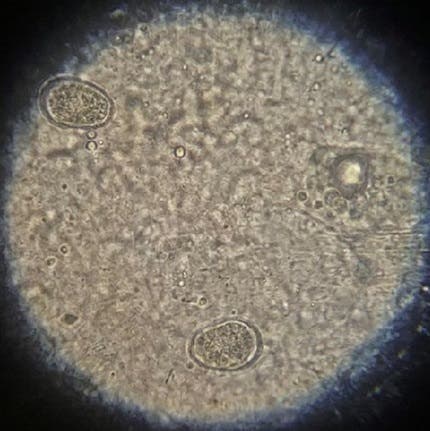What causes coccidiosis in chickens?
The poultry disease, coccidiosis, is a significant parasitic disease that affects broiler chickens, caused by protozoa of the genus Eimeria.
The parasite invades the cells of the intestinal lining, leading to severe health and economic consequences.
So, understanding the causes of coccidiosis and its impacts on poultry production is crucial for effective management and control.
This article explains how different Eimeria species can lead to flock health challenges, and the actions poultry producers can take to improve coccidiosis control.
How do Eimeria species cause coccidiosis in poultry?
Different Eimeria species infect various parts of the bird’s intestines, each peaking at different stages.
Each Eimeria species has a specific prepatent period (time from ingestion of the oocysts to the appearance of oocysts in faeces) and pathogenesis, which influences the timing and severity of clinical symptoms.
The severity of the disease depends on the number of oocysts ingested and the immune status of the birds.
The primary Eimeria species that can affect poultry gut health include:

Oocysts under the microscope
1. Eimeria tenella:
- Infection site: Targets the ceca, a part of the large intestine.
- Pathology: Causes severe haemorrhagic typhlitis, characterised by bloody diarrhoea and caecal cores (solidified caecal content mixed with blood and tissue debris).
- Age of onset: Infections often peak around three to six weeks of age.
- Clinical signs: Birds exhibit lethargy, ruffled feathers, and decreased feed intake
2. Eimeria acervulina:
- Infection site: Infects the upper part of the small intestine.
- Pathology: Leads to pale, watery diarrhoea, with characteristic white plaques on the intestinal mucosa.
- Age of onset: Commonly affects younger birds, with outbreaks typical in two to four- week-old birds.
- Clinical signs: Mild weight loss, reduced feed conversion, and in severe cases, stunted growth.
3. Eimeria maxima:
- Infection site: Found in the middle part of the small intestine.
- Pathology: Causes dilated, fluid-filled intestines and mucoid enteritis, with lesions visible as petechiae and thickened intestinal walls.
- Age of onset: Infections peak around three to six weeks of age.
- Clinical signs: Birds show poor feed conversion and reduced weight gain, with the potential for secondary bacterial infections.

How does coccidiosis spread in broiler farm environments?
The Eimeria oocysts that cause coccidiosis infection are highly resilient and capable of surviving in the poultry production environment for extended periods.
For an oocyst to become infective, it must undergo sporulation, which requires oxygen, moderate temperature (20-30°C), and moisture. This process usually takes one to two days.
Transmission of oocysts
Transmission of the parasites can happen directly – by birds ingesting sporulated oocysts from contaminated feed, water, or litter. Once ingested, the oocysts release sporozoites that invade the cells of the intestinal lining, initiating the infection cycle.
Transmission can also occur indirectly – for example, equipment, tools, and people moving between poultry houses can all carry oocysts on their surfaces, spreading contamination.
Pests such as flies and rodents can act as carriers too, transporting oocysts on their bodies or in their droppings, further spreading the infection and threatening poultry gut health.
Challenges of coccidiosis control – environmental persistence
Controlling coccidiosis can be particularly challenging for poultry producers because Eimeria oocysts are so resilient.
Oocysts have a robust outer wall that protects them from desiccation and chemical damage, as well as extreme temperatures.
Within a broiler shed, the moist and nutrient-rich environment of poultry litter provides an ideal habitat for oocysts, allowing them to remain viable for months.
Contaminated water sources can also harbour Eimeria oocysts for extended periods of time, posing a significant risk of transmission. Birds drinking from contaminated water can ingest oocysts, leading to the spread of coccidiosis and compromising poultry gut health.
The aforementioned robust outer wall of Eimeria also protects oocysts from water treatment chemicals, making them difficult to eliminate from water systems.
How to control Eimeria oocysts to help protect poultry health
Coccidiosis remains a persistent threat to broiler production, meaning vigilant management practices are crucial.
The following management recommendations are vital for controlling oocysts in broiler farm environments and helping protect poultry gut health.
Litter and bedding
- Regularly remove and replace litter to help decrease the concentration of oocysts in the environment, thereby reducing the risk of transmission. This process disrupts the lifecycle of Eimeria by eliminating sporulated oocysts before they can be ingested by the birds.
- Maintaining proper ventilation in poultry houses keeps the litter dry. Dry litter conditions are less favourable for the sporulation of oocysts, therefore reducing their infectivity.
Avoid overcrowding, which can lead to increased faecal contamination and moisture levels in the litter, creating an ideal environment for oocyst survival and sporulation.
Water sources
- Routine cleaning and disinfection prevent the accumulation of unfavourable biofilms and organic matter where oocysts can inhabit and thrive. Using effective disinfectants that can penetrate biofilms ensures that oocysts are eliminated from water delivery systems.
- Ensure water provided is free from contamination to reduce the risk of oocyst ingestion. Regular testing of water sources for pathogens can help identify and address contamination issues promptly.
- Prevent leaks and ensure proper maintenance of water delivery systems to reduce the formation of moist areas where oocysts can survive and thrive. Well-maintained systems help keep the drinking environment clean and safe for the birds.
By understanding coccidiosis causes and implementing these robust control strategies, producers can mitigate the detrimental impacts of poultry sickness, improve intestinal integrity and maximise performance.
Maxiban contains Narasin and Nicarbazin. Legal category: SFA. Monteban contains Narasin. Legal category: SFA. Further information is available from the Datasheet. Use medicines responsibly: www.noah.co.uk/ responsible. Elanco UK AH Limited, Form 2, Bartley Way, Bartley Wood Business Park, Hook RG27 9XA. Telephone: 01256 353131. Email: elancouk@elanco.com
Maxiban, Monteban, Elanco Health Tracking System (HTSi), Elanco and the diagonal bar logo are trademarks of Elanco or its affiliates. © 2024 Elanco or its affiliates.
Date of preparation: 08/2024.